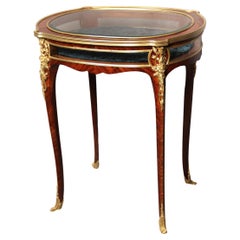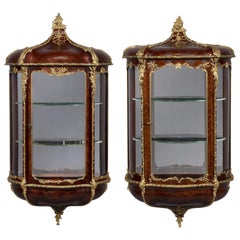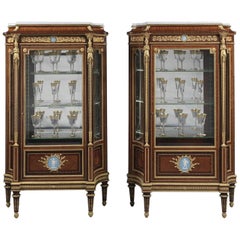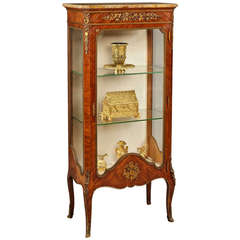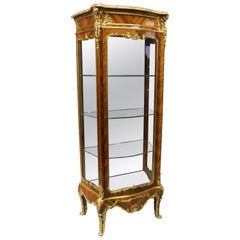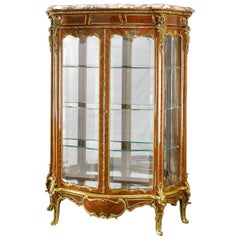Joseph-Emmanuel Zwiener Vitrines
The 19th-century German cabinetmaker Joseph-Emmanuel Zwiener rose to prominence for his beautiful reproductions of Louis XV furniture in the Rococo style. The influence of the Art Nouveau movement can be seen in Zwiener's work as well, and his ornate cabinets, gilded writing desks and exquisitely detailed chests of drawers are just some of the many examples of his mastery of furniture design.
Zwiener was born in Herdon, Germany, around 1848. By 1880, he had moved to Paris and established a workshop on the Rue de la Roquette. Zwiener was quick to earn esteem among the European nobility as a producer of fine furniture. In 1884, he created a replica of the famous Bureau du Roi roll-top desk for King Ludwig II of Bavaria. He also partnered with famed French sculptor Léon Messagé, whose gorgeous designs are credited with helping Zwiener win the gold medal at the 1889 Paris Exposition Universelle.
In 1895, Zwiener returned to Berlin after securing a commission from Wilhelm II. His workshop was taken over by cabinetmaker François Linke. Linke's style was similar to Zwiener's. Linke also continued to work with Messagé, preserving the workshop's tradition of exceptional craftsmanship.
In Germany, Wilhelm II was eager to showcase the talents of German furniture makers to the world. He tasked Zwiener with producing an extensive suite of furniture for his royal palaces. The furniture was exhibited at the German Pavilion during the 1900 Paris Exposition Universelle. Later, many of the pieces followed Wilhelm II to his manor house, Huis Doorn, in the Netherlands, where he lived in exile.
Over his career, Zwiener also produced furniture for elite international clients like New York art collector Charles Tyson Yerkes and French author Baroness Hélène van Zuylen of the Rothschild banking family.
On 1stDibs, find antique Joseph-Emmanuel Zwiener case pieces, tables, wall decorations and more.
Late 19th Century French Belle Époque Antique Joseph-Emmanuel Zwiener Vitrines
Marble, Bronze
Late 19th Century French Belle Époque Antique Joseph-Emmanuel Zwiener Vitrines
Bronze
Late 19th Century French Louis XVI Antique Joseph-Emmanuel Zwiener Vitrines
Bronze
Late 19th Century French Louis XVI Antique Joseph-Emmanuel Zwiener Vitrines
Bronze
19th Century French French Provincial Antique Joseph-Emmanuel Zwiener Vitrines
Glass, Wood
19th Century French Louis XVI Antique Joseph-Emmanuel Zwiener Vitrines
Marble, Bronze
Early 1900s French Louis XVI Antique Joseph-Emmanuel Zwiener Vitrines
Marble, Ormolu, Bronze
Late 19th Century French Louis XVI Antique Joseph-Emmanuel Zwiener Vitrines
Bronze, Ormolu
Early 1900s French Louis XVI Antique Joseph-Emmanuel Zwiener Vitrines
Marble, Bronze
Late 19th Century French Louis XV Antique Joseph-Emmanuel Zwiener Vitrines
Marble, Bronze
19th Century French Louis XV Antique Joseph-Emmanuel Zwiener Vitrines
Bronze
1870s Dutch Renaissance Revival Antique Joseph-Emmanuel Zwiener Vitrines
Art Glass, Oak
Early 1900s North American Louis XVI Antique Joseph-Emmanuel Zwiener Vitrines
Malachite, Metal, Bronze
Early 1900s French Louis XV Antique Joseph-Emmanuel Zwiener Vitrines
Bronze
Mid-20th Century Italian Neoclassical Revival Joseph-Emmanuel Zwiener Vitrines
Hardwood
19th Century French Louis XVI Antique Joseph-Emmanuel Zwiener Vitrines
Bronze
Late 19th Century French Belle Époque Antique Joseph-Emmanuel Zwiener Vitrines
Marble, Bronze
19th Century French Rococo Antique Joseph-Emmanuel Zwiener Vitrines
Bronze

